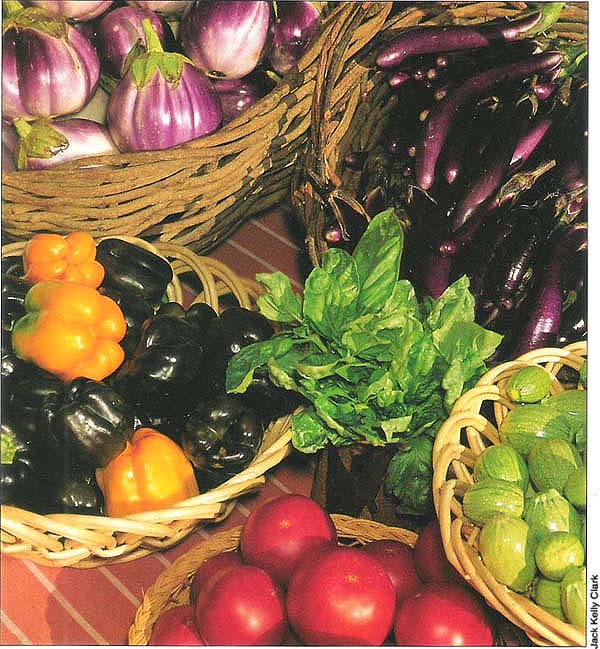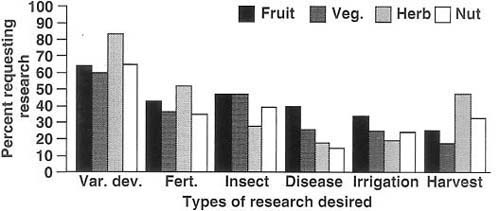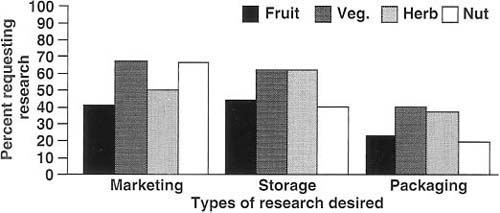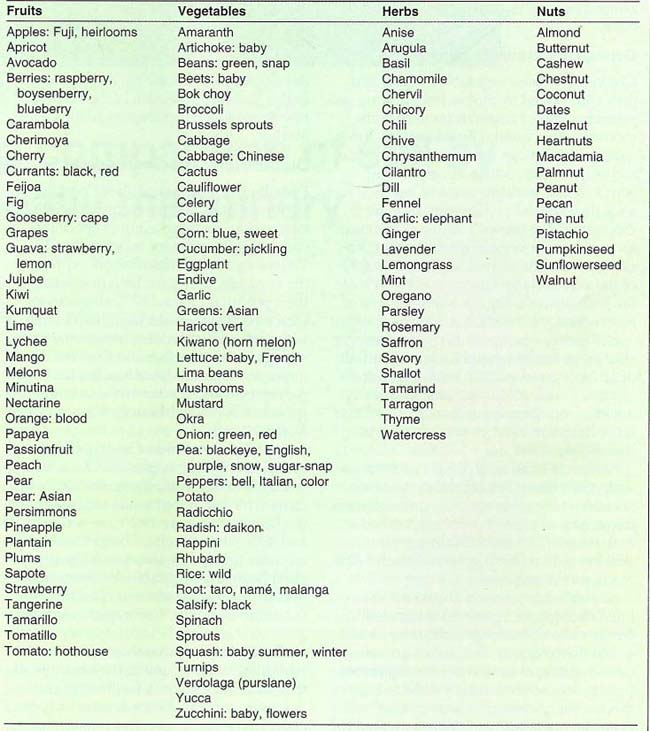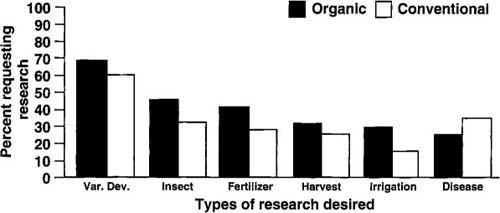All Issues
Fuji apple, radicchio, basil, walnut top specialty crop research needs
Publication Information
California Agriculture 46(4):16-18.
Published July 01, 1992
PDF | Citation | Permissions
Abstract
Growers and distributors list 130 specialty crops they think need research. Heading the list: Fuji apple, radicchio, basil, and walnut.
Full text
Over the last two decades, many California-grown crops that were once considered exotic or “specialty” have become commonplace in supermarkets. Many of these crops have received little or no research attention. A statewide survey of growers and handlers was conducted in 1989 with these objectives: to determine specific research needs and to plan future University studies of specialty crops.
The survey
A questionnaire was sent to 500 growers and distributors (handlers) throughout California. We received 69 responses, a response rate of 14%. Specialty crops were identified for the respondents as unusual varieties of common crops as well as ethnic and exotic crops.
Growers and distributors were asked to list one or more specialty fruit, vegetable, herb, and nut crops needing research attention. They were asked to identify up to five commodities in each category. For each commodity listed, growers were asked to choose from a list of possible areas of research: varietal development, irrigation, fertilization, insect control, disease control, or harvesting. Distributors were asked to choose from among storage, packaging, and marketing as areas of desired research. Growers were also asked to identify their production methods as organic or conventional.
Fig. 1. Growers of specialty fruits, vegetables, herbs, and nuts indicated research in varietal development as their greatest need. Other categories covered in survey: fertilization, insect control, disease control, irrigation, and harvesting.
Fig. 2. Marketing of vegetables and nuts was the strongest research interest among specialty crop distributors surveyed.
Crop diversity
Of the respondents, 33 grew vegetables, 38 grew fruits, 13 grew herbs, and 9 grew nuts. Many growers grew two or more categories of crops. Some growers also marketed their crops – 25 grower/marketers were identified.
Respondents identified 130 commodities as needing research attention. Table 1 lists them under four categories: fruits, vegetables, herbs, and nuts. Specialty vegetables (48 commodities) head the list as having the most needs for research; 38 fruits and 27 herbs also require research attention. Nuts (17 crops) are less frequently mentioned as needing study. Identification of the 130 specialty commodities attests to their growing appeal among farmers, marketers, and consumers.
A little more than 10% of the respondents indicated no desire for research on any crop. Of the growers and handlers responding, 18.9% identified only one commodity as needing research attention, 17.4% desired research on as many as 6 out of 10 commodities, and 5.8% listed from 16 to 20 crops requiring research.
Crops most identified
Fuji apple was listed by all respondents as the number-one specialty fruit requiring research study. Radicchio was the vegetable most frequently cited as needing research attention. Among herbs and nuts, basil and walnut were listed as the leading crops requiring study. All four specialty crops are commonly found today in California supermarkets. The survey indicates that university research may be lagging behind the production and marketing of these specialties. Table 2 lists the five crops most frequently selected by respondents as needing study, arranged by crop category.
Fig. 3. Varietal development was the most pressing research need expressed by both organic and conventional growers of specialty crops.
Growers' research needs
Growers of fruits, vegetables, herbs, and nuts were asked to choose from among six possible areas of research for each commodity listed: varietal development, irrigation, fertilization, insect control, disease control, and harvesting. A respondent could choose multiple areas of research for a single commodity. Growers from all crop categories showed strong preference for research on varietal development. Varietal development was requested by 60% of the vegetable producers and by 84% of the herb growers (fig. 1). No other area of research request ranked so high.
All grower groups strongly desired studies on fertilizer application. Over half of all herb growers (52%) wanted such studies. Fertilization was least frequently noted by nut growers, although even there more than one-third were interested in such work (35%).
Growers in all crop categories strongly supported insect management studies. Specialty fruit and vegetable growers most frequently requested university attention in that area (47% for each category). Among nut and herb growers, 40 and 32% made similar requests.
Overall, herb growers came out the most strongly for research on harvesting (48%); only 18% of vegetable growers requested attention in that area. Grower concerns for irrigation or water management practices were not strongly reflected in this survey. Among the four grower groups, between 25 and 35% expressed the need for university research in water application. These figures are well below those for other areas of research interest. In light of California's drought, one might have expected to see more requests for irrigation studies had the survey been conducted in 1992.
Overall areas of research requests varied greatly among the four crop categories. For example, nut growers considered disease control to be the area of least concern (15%), whereas 40% of fruit growers wanted study in that area. In three of six research areas, herb growers were the most concerned about production (varietal development, fertilization, and harvesting), a possible reflection of the relative novelty of this crop category in the U.S. market.
Distributors' research needs
Distributors were asked about possible research assistance in marketing, storage, and packaging. Marketing of specialty crops was the primary concern (fig. 2). Vegetable and nut distributors expressed the strongest desire for help in marketing their products (68 and 67%, respectively). Of the respondents desiring help in marketing specialty commodities, many were both growers and distributors. This may indicate increased opportunities for Farm Advisors to become involved in both the production and marketing of certain commodities.
Equal proportions of herb and vegetable distributors requested UC assistance for research on storage (62%). Specialty fruit and nut growers also asked for studies on storage from UC researchers (43 and 40%, respectively). The greater rate of requests for storage assistance among specialty herb and vegetable distributors is not surprising, as both commodities are subject to rapid decline in quality immediately after harvest.
Finally, of the three research areas queried, distributors showed the least interest in packaging (fig. 2). As with storage, however, concern for packaging of specialty herbs and vegetables ranked higher than for specialty fruits and nuts (38, 41, 24, and 20%, respectively) (fig. 2). Herbs and vegetables usually are more perishable, so their distributors are more concerned with extending shelf lives.
Organic versus conventional
Growers were asked to identify themselves as organic or conventional producers. Thirty-three of the respondents (48%) identified themselves as organic growers. Organic growers requested greater research priority for insect control, fertilization, irrigation, and varietal development (fig. 3). For conventional and organic growers alike, varietal development was the first priority for research.
Almost twice as any organic growers as conventional growers requested improvements in farm irrigation. Only 16% of the conventional growers listed irrigation as a priority for research. When compared to conventional growers, organic growers expressed a greater need for research attention in all production areas queried except disease control.
Conclusions
Growers and distributors listed a total of 130 California specialty crops as deserving research. In general, across all crop categories, growers indicated a consistent need for varietal development of their commodities. Growers also expressed then-need for fertilizer trials and insect management techniques.
Distributors of all crop types expressed interest in marketing assistance. Vegetable and herb distributors were most concerned with shelf lives of their perishable commodities, and expressed their desire for UC assistance in improving storage and packaging methods.
Organic growers requested help in all areas of production, except disease management, more frequently than did conventional growers. Compared with conventional growers, organic growers were more likely to request assistance in varietal development, insect control, fertilization, irrigation, and harvesting.
Farm Advisors and Extension Specialists doing field work may want to organize their research in accordance with our findings, and concentrate their work in this order of importance: varietal development and testing, insect management, fertilizer trials, harvesting, and disease control.
University and private industry personnel working with specialty growers and distributors need to be acutely aware of their marketing needs. Recommendations on growing specialty commodities should be based on ease of production as well as on market demand for the particular crop.



